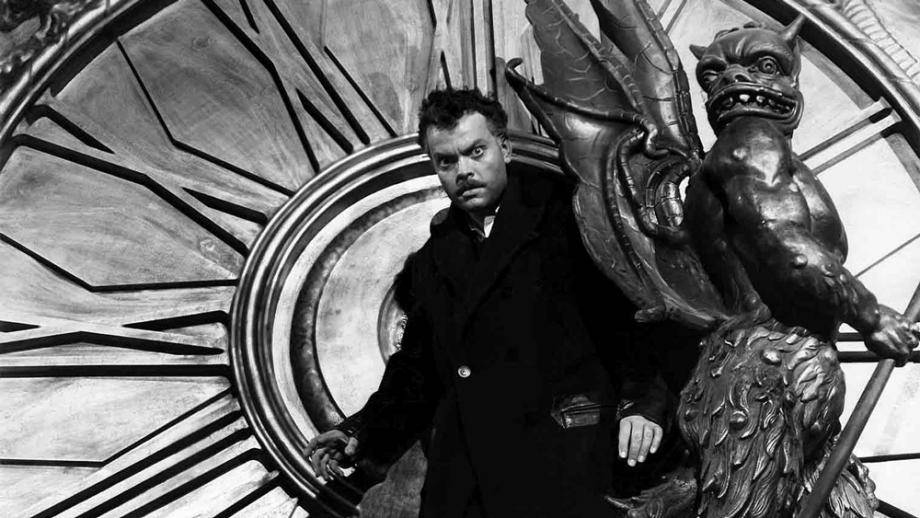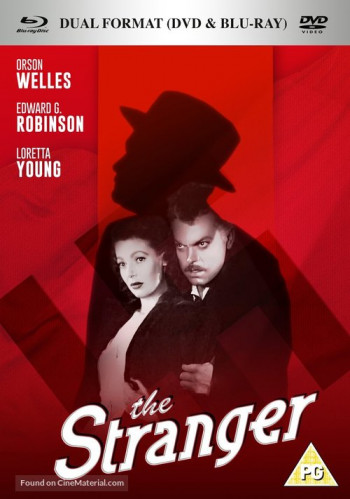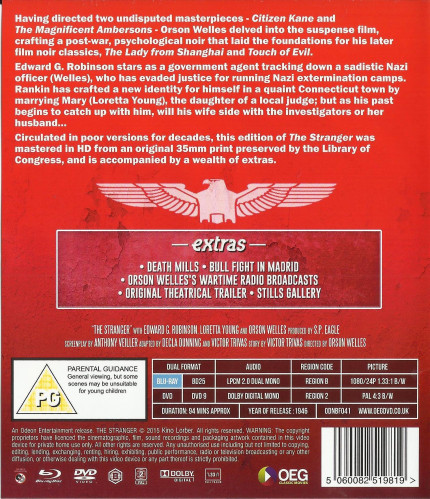THE STRANGER [1946 / 2015] [Blu-ray + DVD] [UK Release]
The Most Deceitful Man A Woman Ever Loved!
Having directed two undisputed masterpieces like ‘Citizen Kane’ and ‘The Magnificent Ambersons,’ Orson Welles delved into the suspense film, crafting a post-war, psychological noir that laid the foundations for his later “film noir” classics, ‘The Lady from Shanghai’ and ‘Touch of Evil.’
Edward G. Robinson stars as a government agent tracking down a sadistic Nazi officer Franz Kindler [Orson Welles], who has evaded justice for running Nazi extermination camps. Rankin has crafted a new identity for himself in a quaint Connecticut town by marrying Mary Longstreet [Loretta Young], the daughter of a local judge, but as his past begins to catch up with him will his wife side with the investigators or her husband…
Circulated in poor versions for decades, this edition of ‘THE STRANGER’ was remastered in HD [1080p] from an original 35mm print preserved by the Library of Congress and this special edition to celebrate the 100th year of the birth of Orson Welles is accompanied by a wealth of extras including “Death Mills” documentary by director Billy Wilder. Original Theatrical Trailer and an excerpt from the TV series: “Around the World with Orson Welles,” plus the radio broadcasts by Orson Welles.
FILM FACT No.1: Awards and Nominations: 1947 Academy Awards®: Nominated: Best Writing for an Original Story for Victor Trivas. 1947 Venice Film Festival: Nominated: Grand International Award for Orson Welles.
FILM FACT No.2: The debut issue (July – August 1946) of the short-lived pulp digest Movie Mystery Magazine presented a novelized condensation of the screenplay for ‘THE STRANGER.’ A half-hour adaptation of ‘THE STRANGER’ aired on CBS Radio's “This Is Hollywood” on the 7th December, 1946. Edward G. Robinson re-created his role from the film, performing with Ruth Hussey, Roland Morris, and Gerald Mohr. The copyright on the film ‘THE STRANGER’ originally belonged to The Haig Corporation, but the film is in the public domain because the producers did not renew the copyright in 1973.
Cast: Edward G. Robinson, Loretta Young, Orson Welles, Philip Merivale, Richard Long, Konstantin Shayne, Byron Keith, Billy House, Martha Wentworth, David Bond (uncredited), John Brown (uncredited), Neal Dodd (uncredited), Nancy Evans (uncredited), Adolph Faylauer (uncredited), Fred Godoy (uncredited), Joseph Granby (uncredited), Ethan Laidlaw (uncredited), Ruth Lee (uncredited), Lillian Molieri (uncredited), Isabel O'Madigan (uncredited), Gabriel Peralta (uncredited), Gerald Pierce (uncredited), Robert Raison (uncredited), Rebel Randall (uncredited), Johnny Sands (uncredited), Erskine Sanford (uncredited), Pietro Sosso (uncredited), Brother Theodore (uncredited) and Josephine Victor (uncredited)
Director: Orson Welles
Producers: Sam Spiegel and John Huston (uncredited)
Screenplay: Anthony Veiller, Decla Dunning (adaptation), John Huston (uncredited), Orson Welles (uncredited) and Victor Trivas (story/ adaptation)
Composer: Bronisław Kaper
Cinematography: Russell Metty, A.S.C. (Director of Photography)
Image Resolution: Blu-ray: 1080p (Black-and-White)
Aspect Ratio: 1.37:1
Audio: Blu-ray: English: 2.0 LPCM Dual Mono Audio
DVD: English: 1.0 Dolby Digital Mono Audio
Subtitles: None
Running Time: 94 minutes
Region: Region B/2
Number of discs: 2
Studio: RKO Radio Pictures / OEG Classic Movies
Andrew’s Blu-ray Review: Within just five years, Orson Welles had fallen from the position of Boy Genius with complete artistic control over his work to an industry-wide failure, forced to take on ‘THE STRANGER’ to prove he could work within the studio system as well as anyone. After a four-year hiatus and a lot of bad press, Orson Welles was eager to prove himself capable of bringing in a picture on time and within budget. The result was ‘THE STRANGER,’ Orson Welles's most conventional film but one which nevertheless bears some of his distinctive touches. There are also little jokes buried in each scene, as when Edward G. Robinson is knocked cold by a gymnast’s ring and the camera glances past a sign warning "use this apparatus at your own risk." But perhaps the most remarkable thing about ‘THE STRANGER,’ is that production proceeded without delays, incidents, hassles with studio executives, or the kind of scandals that marked the shooting. In that respect, it's the most un-Wellesian of any Orson Welles's film.
Orson Welles directed what is widely considered one of the all-time greatest films, ‘Citizen Kane,’ among several other acclaimed works, but his only bona fide box office success is the rarely-discussed ‘THE STRANGER.’ After the controversial debut of ‘Citizen Kane’ and the poor performance of his second directorial effort, ‘The Magnificent Ambersons,’ Orson Welles found it hard to get work as a director. He took a few years off to focus on acting and starting a family before returning to the director’s chair for the 1946 film ‘THE STRANGER.’
Orson Welles stars in ‘THE STRANGER,’ where he plays Franz Kindler, an infamous Nazi war criminal and after destroying all evidence of his past atrocities, Franz Kindler moves to a small town in Connecticut where he assumes the identity of a prep school teacher and marries Mary Longstreet [Loretta Young], the daughter of a Supreme Court Justice. He believes himself to be above suspicion, oblivious to the fact that a member of the Allied War Crimes Commission, Mr. Wilson [Edward G. Robinson], is on his trail and Mr. Wilson is charged with the task of convincing the naive Mary Longstreet of her new husband’s true identity in order to capture him.
With its game of cat and mouse and the exciting conclusion atop a clock tower, ‘THE STRANGER’ is ostensibly a standard drama-thriller. But further inspection reveals it to be more complex than that; it serves as a transitory piece in Orson Welles career. The film contains many of the artistic flourishes of his early works where Orson Welles keen direction includes several lengthy, albeit subtle, uninterrupted takes, while laying the groundwork for the “film noir” classics he would go on to create, including his follow-up feature, ‘The Lady from Shanghai.’
‘THE STRANGER’ was produced shortly after the conclusion of World War II, and although the war was over, the American people were still living in fear of another attack. The film plays on that fear, leading audiences to believe that the person sitting next to them could be secretly plotting to strike from within. The sense of unease is perpetuated by the inclusion of actual concentration camp footage; the first film to do so. It’s interesting to see Orson Welles take on a darker role rather than that of the hero, and he delivers a performance that is among his best. Edward G. Robinson’s portrayal of Mr. Wilson is equally commendable.
Years after ‘THE STRANGER’ was released Orson Welles and Edward G. Robinson spoke of how they disliked working with each other. Any conflict the two legendary actors had behind-the-scenes certainly did not show up on camera as they play off each other brilliantly. The strongest performances in the film come when the diminutive Robinson puts the lofty Welles on the defensive as he presses to learn the truth about his past. Another strong performance comes from the beautiful Loretta Young as the innocent Mary Longstreet whose steadfast will to defend her husband leads her gradually into madness.
Blu-ray Image Quality – OEG Classic Movies present an 1080p encoded image that was mastered from archival 35mm elements which were preserved by the Library of Congress and this high-definition presentation offers a noticeable improvement, and it's apparent there were minimal restoration efforts done to this film and is presented here as is, warts and all, which is more or less a blessing in disguise. The 1.37:1 aspect ratio image displays strong definition and clarity for most of the film's runtime and overall resolution is really excellent. Fine lines and textures in various scenes are nicely detailed with some particularly revealing close-ups. A thin layer of natural grain washes over the picture and remains consistent throughout. Contrast is better balanced and accurate for the most part, as there a few instances of blooming in the highlights. Black levels too, are often rich and true with good gradational details, but some sequences appear a tad faded and murky. In the end, this is a good presentation of this film and you will not get anything better and I wish OEG Classic Movies had spent a lot more money on this classic Orson Welles film, as for me there are far too many white speckles and fine white lines running on the left hand side of the screen that keep appearing, as well horrible film gate dirt down the right hand of the screen, which too me sort of spoilt the enjoyment of the film, but unfortunately I expect other companies who have brought out this Blu-ray had the same problem, so sadly I am stuck with it, which is a shame as it is a totally brilliant tour-de-force espionage thriller film from Orson Welles. Please Note: Playback Region B/2: This will not play on most Blu-ray players sold in North America, Central America, South America, Japan, North Korea, South Korea, Taiwan, Hong Kong and Southeast Asia. Learn more about Blu-ray region specifications.
Blu-ray Audio Quality – OEG Classic Movies brings you a choice of two audio soundtracks and on the Blu-ray it is 2.0 LPCM Dual Mono Audio and on the DVD is 1.0 Dolby Digital Mono Audio, and very confused why they have done, which is all very strange. Vocals are cleanly and intelligibly delivered in the centre, and overall imaging comes with strong acoustical details. The design is not particularly dynamic, but the mid-range is nicely balanced and well-defined, providing the soundstage with an appreciably broad presence. Bass is pretty limited though there's just enough to give the music and the voices of actors some mild weight. All in all, it's still a good track and an improvement over its counterpart.
Blu-ray Special Features and Extras:
Special Feature: ‘DEATH MILLS’ [1945] [480i] [1.37:1] [32:40] This is an information film about the Nazi Death Camps with footage that appeared briefly in ‘THE STRANGER’ film. The film starts very badly with those countdown numbers and I cannot understand why they could not have edited this out and started it where the main title appears. Also another puzzle that I do not understand is that right at the end of the documentary you get short repeats of the documentary you have just viewed. This was originally made with a German soundtrack for screening in occupied Germany and Austria, this film was the first documentary to show what the Allies found when they liberated the Nazi extermination camps: the survivors, the conditions, and the evidence of mass murder. The film includes accounts of the economic aspects of the camps' operation, the interrogation of captured camp personnel, and the enforced visits of the inhabitants of neighbouring towns, who, along with the rest of their compatriots, are blamed for complicity in the Nazi crimes, one of the few such condemnations in the Allied war records. ‘DEATH MILLS’ [‘Die Todesmühlen’] is a 1945 American film directed by Billy Wilder and produced by the United States Department of War. The film was intended for German audiences to educate them about the atrocities committed by the Nazi regime. For the German version, Die Todesmühlen, Hanus Burger is credited as the writer and director, while Wilder supervised the editing. Wilder is credited with directing the English-language version. The film is a much-abbreviated version of ‘German Concentration Camps Factual Survey,’ a 1945 British government documentary that was not completed until nearly seven decades later.
Special Feature: Bull Fight in Madrid [1955] [1080p] [1.37:1] [15:12] This is an Extract from ‘Around the World with Orson Welles.’ Orson Welles pitches a film about the world of matadors, bullfights, and their spectators. Cast: Orson Welles, Kenneth Tynan and Elaine Dundy. The quality of the black-and-white 1080p image is spectacular; it is such a shame the main film could not have been of high quality standards as this particular special feature.
Special Feature: CBC Orson Welles's Wartime Radio Broadcasts[1941 – 1942] This particular extra includes four WWII-era broadcasts that Orson Welles voiced and was broadcast on Canadian Broadcasting Corporation apart from one, which is a great extra inclusion. Here you have four audio only radio broadcasts, which sadly are of very poor quality and they are as follows:
From The Series: Nazi Eyes on Canada [CBC] ALAMEDA [29:00] Orson Welles performs in, but did not direct. This dramatization of the Nazi takeover of the small Canadian town of Alameda. It was produced by the Canadian Broadcasting Corporation, as part of the Third Victory War Drive. This was broadcast on the 25th December, 1942.
From The Series: Hello Americans [CBC] BRAZIL [29:00] This is the Premiere episode of a lively variety program intended to foster Inter-American relations, and featuring an appearance by Carmen Miranda. The cinematic counterpart of this program was Orson Welles’s ill-fated film ‘IT’S ALL TRUE.’ This was broadcast on the 15th November, 1942.
From The Series: Ceiling Unlimited [CBC] WAR WORKERS [29:00] In this episode of Orson Welles’s patriotic aviation themed program “He Swipes The Microphone” from a Nazi Spy point of view and broadcast to Berlin with a tour of the Lockheed-Vega Corporation plant. This was a light-hearted spin on “The War of the World” type spoof broadcast, where Orson Welles employs the pseudo-documentary approach for which he had become famous for. This was broadcast on the 14th December, 1942.
From The Series: Orson Welles Commentaries [ABC] BIKINI ATOMIC TEST [14:00] Airing shortly after the release of ‘THE STRANGER’ film. This particular episode is of Orson Welles’s political opinion program discussing America’s further development of the Atomic Bomb, as well as the demise of The Office of Price Administration. This was broadcast on the 30th June, 1946.
Theatrical Trailer [1946] [480i] [1.37:1] [1:16] This is the original Theatrical Trailer of ‘THE STRANGER.’ Despite the grainy quality, it is still a great dramatic presentation trailer.
Special Feature: Stills Gallery [2015] [1080p] Here you get to view a gallery of black-and-white and colour images of a total of fifteen publicity photos, storyboards sketches, and Cinema Film Posters from different countries. To view them you have to keep pressing next button on your remote control.
Finally, though not as celebrated as Orson Welles's two previous films, ‘THE STRANGER’ is a crucial part of the director's filmography, proving he could create a commercial success without fully sacrificing his artistic integrity. It's a slick, thematically substantial post-war thriller, and it holds up well next to some of the best noir films of its day. ‘THE STRANGER’ has had a chequered history with the home video format like many films in the public domain, Odeon Entertainment has treated this classic film with respect, giving us a detailed high definition transfer, a great audio track, and a disc that includes an informative series of vintage radio broadcasts. It's a definite upgrade from previous Blu-ray releases, which had DNR [Digital Noise Reduction] done to death and also featured an audio track that should have been upgraded. ‘THE STRANGER’ may not be Orson Welles’s best effort, and it’s certainly not his most celebrated work, but it’s a great film worthy of recognition. As it is in the public domain, there are dozens of poor-quality versions of the film floating around on home video, but OEG Classic Movies Blu-ray presentation is slightly let down quality wise, but you do get some nice extras as compensation. ‘THE STRANGER’ is a better-than-average spy-thriller and particularly relevant for the time period of its release and most definitely worth discovering for Orson Welles fans everywhere. Highly Recommended!
Andrew C. Miller – Your Ultimate No.1 Film Aficionado
Le Cinema Paradiso
United Kingdom



